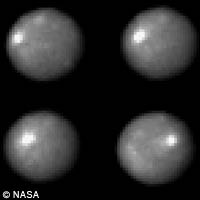10th planet found - and 11th and 12th
The International Astronomical Union (IAU) has made a formal proposal for the definition of a planet. If accepted in the IAU General Assembly in Prague, which votes on 24 August, there will be 12 rather than nine planets in the solar system. They will include Pluto and a series of 'Plutons' - a new class of planet. You may wonder what the point is in reclassifying the planets. Anyone of school age with a passing interest in space could mention most of the planets - their names seem concrete and unassailable. However, the problem comes from one planet in particular - Pluto. Planets were so-called because of the ancient Greeks, who noticed that a few of the stars - often bright ones - tended to move slowly about the night sky, while the majority of the rest remained stationary. The ancient Greeks referred to these itinerant stars as 'planetes', or wanderers. Science eventually found that these moving stars were in fact not stars at all, but rocky or gassy worlds spinning around the Sun in the same way as our planet Earth does. In the 1900s, astronomers William H. Pickering and Percival Lowell noted that there should be something, as yet undiscovered, to explain the occasionally erratic movement of what was then the final planet - Neptune. This began an early version of the space race, as mathematicians pinpointed potential sites for this undiscovered world, astronomers raced to find the body. The culprit was eventually tracked down by Clyde Tombaugh on 18 February, 1930. Ironically, the erratic motion of Neptune was eventually found to be an error, and the discovery of Pluto simply a coincidence. In the excitement, nobody considered whether this new world - eventually named Pluto - was indeed a planet. Many other objects move around, such as asteroids, meteors and comets. Although Pluto was large, larger objects have since been discovered, particularly in an area known as the Kuiper belt, beyond Neptune. The issue came to a head when a new body - 2003 UB313 or 'Xena' was found to be twice the size of Pluto. If Pluto is a planet, then so is this body. IAU President Ron Ekers explains: 'Modern science provides much more knowledge than the simple fact that objects orbiting the Sun appear to move with respect to the background of fixed stars. For example, recent new discoveries have been made of objects in the outer regions of our Solar System that have sizes comparable to and larger than Pluto. These discoveries have rightfully called into question whether or not they should be considered as new 'planets',' he said. The new definition for a planet requires 'the physical properties of an object to determine its true nature. An object is thus defined as a planet based on its intrinsic physical nature. Two conditions must be satisfied for an object to be called a 'planet'. First, the object must be in orbit around a star, while not being itself a star. Second, the object must be large enough (or more technically correct, massive enough) for its own gravity to pull it into a nearly spherical shape. The shape of objects with mass above 5 x 10 to the power of 20 kg and diameter greater than 800 km would normally be determined by self-gravity, but all borderline cases would have to be established by observation,' according to the IAU This then conveniently eliminates many moons - including our own - which are significantly larger than Pluto. Owen Gingerich, the Chair of the Planet Definition Committee says: 'In July we had vigorous discussions of both the scientific and the cultural/historical issues, and on the second morning several members admitted that they had not slept well, worrying that we would not be able to reach a consensus. But by the end of a long day, the miracle had happened: we had reached a unanimous agreement.' This re-definition now gives us more planets. Firstly, the former asteroid, 1 Ceres will now be reclassified as planet Ceres. Ceres resides in the asteroid belt between Mars and Jupiter, the largest of a number of large asteroids in this area. The body is not seen easily and is rather small, but fits the new definition, and is the only body in the asteroid belt to have a spherical shape. Perhaps more interesting is the potential at the end of the solar system. Pluto, its moon Charon, and 'Xena' (formally known as 2003 UB313), the body that triggered this round of reclassification, are recognised as a planets, but all in a new class - Plutons. This leaves room for further discoveries at the fringes of the solar system. In case you are confused by the new system, and how our solar system may look, here is the proposed list of planets, in increasing distance from the sun, their classification, and approximate size: Mercury - Classical planet, 4,879 km in diameter Venus - Classical planet, 12,104 km Earth - Classical planet, 12,746 km Mars - Classical planet, 6,780 km Ceres - Dwarf Planet, 952 km Jupiter - Classical planet, 138,346 km Saturn - Classical planet, 114,632 km Uranus - Classical planet, 50,532 km Neptune - Classical planet, 49,105 km Pluto - Pluton, 2306 +/- 20 km Charon - Pluton, 1205 +/- 2 km 2003 UB313 ('Xena') - Pluton, 2400 +/- 100 km



